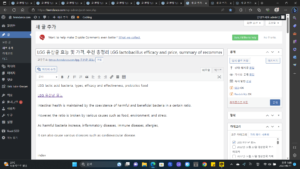Hello, this is Cul James who aims for a healthy life. Lactobacillus has been firmly maintaining the number one purchase rate of health functional food for many years. As there are many types of lactobacillus on the market, in this article, we will look at the efficacy and side effects (summary) of LGG lactobacillus, which has been loved for a long time.

index
What are probiotics
What are prebiotics
Probiotics Efficacy and Effects
types of probiotics
Prebiotics Benefits
What are probiotics
It is a general term for bacteria and microorganisms that are beneficial to our body.
What are prebiotics
It refers to complex carbohydrates that act as food to help the growth and proliferation of beneficial bacteria.
Prebiotics Efficacy and Effects
It increases the beneficial bacteria in the intestine and has the effect of inhibiting the proliferation of harmful bacteria.
There are 19 species of prebiotics approved in Korea, the most representative of which is
There are lactic acid bacteria.
;Suppression of harmful bacteria, proliferation of beneficial bacteria and lactic acid bacteria
;help calcium absorption, vitamin synthesis
;Cholesterol synthesis reduction and decomposition action
;Immune enhancement and infection prevention, anti-cancer effect
;Prevention and treatment of inflammatory bowel disease, enteritis, etc.
Helps women’s vaginal health
;Helps reduce body fat
Helps prevent skin diseases such as allergies and dermatitis
Helps prevent Helicobacter pylori infection and treat gastric ulcer caused by Helicobacter pylori
; Helps prevent liver cirrhosis and tooth decay
It can help in the preventive dimension of various diseases rather than the purpose of treatment.
If you have a disease, you need to be careful when taking it, especially if you have an immune-related disease.
There are many health foods with preobiotics lactic acid bacteria.
In order to be recognized as functional, the number of viable bacteria living by the expiration date is 100 million CFU/g or more.
do. As the storage period passes, the viable cell count gradually decreases.
Probiotic products often contain a variety of strains.
However, in most cases, there are 1 or 2 strains, and other strains are included in low proportions.
Therefore, it may not be effective against all strains.
There are 11 species of probiotics Lactobacillus strains approved in Korea, which are microorganisms that metabolize by fermentation.
It lives mainly in the small intestine.
Lactobacilli, also called lactobacilli, are bacteria that break down carbohydrates into lactic acid.
Lactobacillus acidophilus: Suppression of harmful bacteria, prevention of constipation/diarrhea, anti-cancer, cholesterol lowering, vitamin B group synthesis, anti-inflammation, etc.
Lactobacillus Platarum: Kimchi fermented sour taste, anti-cancer, immunity enhancement, antibacterial, virus suppression
Lactobacillus rhamnosus: LGG lactic acid bacteria, allergy, dermatitis, atopy, bowel syndrome, immune regulation, etc., good intestinal settlement
Lactobacillus casei: digestion, anti-cancer, immunity, acid resistance, growth inhibition of Helicobacter pylori
Lactobacillus gasseri: increase in allergy immune index, decrease intestinal infection, decrease vaginal acidity in women, suppress Helicobacter pylori
Lactobacillus bulgaricus: Helps with constipation and diarrhea, produces immune substances, antibacterial substances, helps with lactose intolerance
Lactobacillus Fermentum: Suppression of viral infection, improvement of symptoms of female disease and urinary tract infection
Lactobacillus reuteri: Suppresses the proliferation of harmful bacteria, improves diarrhea in infants, strengthens immunity, and helps improve female vaginitis
Salivarius: Irritable bowel syndrome, inhibition of pathogenic bacteria, inhibition of bacterial overgrowth in the small intestine
Helveticus: Suppression of harmful bacteria, suppression of inflammation of the mucous membrane of the large intestine
Bifidobacterium is a probiotic that is resistant to stomach acid and bile and lives in the large intestine.
It decreases with age, and there are 4 domestic permits.
Bifidobacterium longum: Suppresses harmful bacteria, lowers cholesterol, suppresses colon cancer, helps with diarrhea, enteritis, and bowel syndrome
Bifidobacterium animalis lactis: Proliferation of lactic acid bacteria, suppression of harmful bacteria, relief of colitis, increase of antibody formation
Brev (helps with constipation, strengthens mucosal barrier function) Bifidum
Enterococcus Pesium, Faecalis: Strengthen immune NK cell activity, improve skin disease, strengthen infection resistance
On the other hand, prebiotics are many types of dietary fiber that are not broken down by digestive enzymes and are broken down by beneficial bacteria.
used as an energy source.
Prebiotics Benefits
Helps with gut health.
It creates a balanced growth environment for intestinal microorganisms.
Helps in the absorption of minerals such as magnesium and calcium.
Prevents inflammatory bowel disease.
Helps to prevent constipation, remove toxins, and lose weight.
It has the effect of increasing immunity and improving cardiovascular disease.
Prebiotics can be taken as nutritional supplements or through food.
Excessive intake can cause bloating, vomiting, gas, and diarrhea.
fructooligosaccharide, fiber
– Carrots, sweet potatoes, seaweed, garlic, cabbage, etc.
– Oat, banana corn, soybean, etc.
Depending on your usual eating habits, your intake may not be enough, but you may be getting enough.
Depending on the individual, this may or may not help.